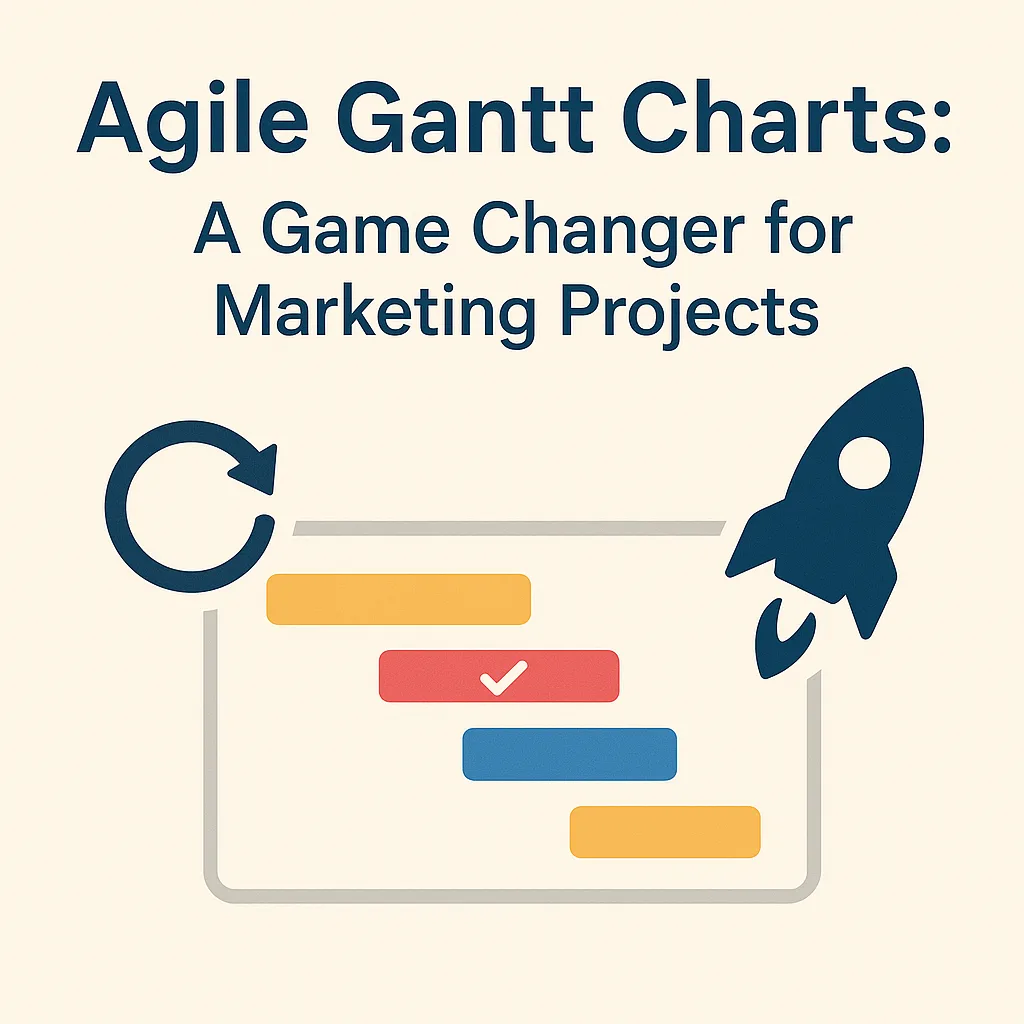Introduction to Agile Gantt Charts
In marketing, where campaigns must adapt to changing consumer behaviors and market trends, the need for effective project management tools is paramount. One such tool that has emerged as a game changer is the Agile Gantt Chart. This innovative approach combines the structured timeline of traditional Gantt charts with the flexibility of agile methodologies, making it particularly relevant for marketing projects.
Definition of Agile Gantt Charts
Agile Gantt Charts are a visual project management tool that integrates the principles of agile methodology with the timeline-oriented structure of traditional Gantt charts. Unlike standard Gantt charts, which provide a static view of project timelines and dependencies, Agile Gantt Charts allow for dynamic updates and adjustments. This means that as marketing teams receive feedback or encounter new challenges, they can easily modify their plans without losing sight of the overall project timeline. This adaptability is crucial in marketing, where campaigns often require real-time adjustments to optimize performance and engagement.
Comparison with Traditional Gantt Charts
While traditional Gantt charts are effective for outlining project timelines and dependencies, they often lack the flexibility needed in agile environments. Here are some key differences:
- Flexibility: Traditional Gantt charts are typically rigid, making it difficult to accommodate changes once the project is underway. In contrast, Agile Gantt Charts are designed to be updated frequently, allowing teams to pivot quickly in response to new information or shifting priorities.
- Collaboration: Agile Gantt Charts promote collaboration among team members by providing a shared visual representation of the project that can be easily modified. This contrasts with traditional Gantt charts, which may be less accessible and harder to update collaboratively.
- Focus on Iteration: Agile methodologies emphasize iterative progress and continuous improvement. Agile Gantt Charts reflect this by allowing teams to break projects into smaller, manageable tasks that can be completed in short cycles, facilitating regular feedback and adjustments.
Importance of Adaptability in Marketing Projects
In marketing, adaptability is not just beneficial; it is essential. Campaigns must respond to real-time data, consumer feedback, and competitive actions. Agile Gantt Charts support this need for adaptability by:
- Enabling Quick Adjustments: Marketing teams can quickly adjust timelines and tasks based on performance metrics, ensuring that campaigns remain relevant and effective.
- Enhancing Responsiveness: With the ability to visualize project progress and make real-time changes, teams can respond to market shifts more effectively, ensuring that their strategies align with current trends.
- Fostering Continuous Improvement: By breaking projects into smaller tasks and allowing for regular reviews, Agile Gantt Charts encourage a culture of continuous improvement, where teams can learn from each iteration and apply those lessons to future campaigns.
The Need for Agile in Marketing Projects
The ability to adapt and respond to changing conditions is crucial. Traditional project management methods often fall short in addressing the unique challenges faced by marketing teams. This is where agile methodologies, particularly agile Gantt charts, come into play as transformative tools for managing marketing projects effectively. Here are some key challenges that agile approaches can help overcome:
- Rapidly Changing Market Conditions: Marketing landscapes are constantly evolving due to shifts in consumer behavior, technological advancements, and competitive pressures. Agile methodologies allow marketing teams to pivot quickly in response to these changes, ensuring that campaigns remain relevant and effective. By utilizing agile Gantt charts, teams can visualize project timelines and adjust tasks dynamically, accommodating new insights and market trends as they arise.
- The Need for Quick Iterations and Feedback: In marketing, the ability to test and iterate on campaigns is vital for success. Agile practices emphasize short development cycles, known as sprints, which enable teams to launch campaigns, gather feedback, and make necessary adjustments in real-time. Agile Gantt charts facilitate this process by providing a clear overview of project phases, allowing teams to plan, execute, and refine their strategies based on immediate feedback from stakeholders and customers.
- Collaboration Across Diverse Teams: Marketing projects often involve collaboration among various departments, including creative, analytics, sales, and customer service. Agile methodologies foster a culture of collaboration and communication, breaking down silos that can hinder project progress. Agile Gantt charts serve as a central communication tool, helping teams coordinate efforts, share updates, and align on goals, ultimately leading to more cohesive and successful marketing initiatives.
By integrating agile Gantt charts into their project management practices, marketing managers and project managers can enhance their ability to navigate the complexities of modern marketing. This approach not only streamlines campaign execution but also empowers teams to be more responsive and innovative in their strategies.
Benefits of Using Agile Gantt Charts in Marketing
Campaigns often evolve and change direction. Integrating Agile Gantt Charts into project management can significantly enhance the effectiveness and efficiency of marketing initiatives. Here are some key benefits of utilizing Agile Gantt Charts in marketing strategies:
- Enhanced Visibility of Project Timelines and Tasks: Agile Gantt Charts provide a clear visual representation of project timelines, allowing marketing teams to see the entire scope of a campaign at a glance. This visibility helps in tracking progress against deadlines, ensuring that all team members are aware of their responsibilities and the overall project timeline. By having a comprehensive view, teams can better manage their time and resources, leading to more successful campaign execution.
- Improved Team Collaboration and Communication: With Agile Gantt Charts, team members can easily share updates and changes in real-time. This fosters a collaborative environment where everyone is on the same page regarding project status and task assignments. Enhanced communication reduces the likelihood of misunderstandings and ensures that all stakeholders are informed about progress and any potential roadblocks, ultimately leading to a more cohesive team effort.
- Ability to Prioritize Tasks Based on Marketing Objectives: Agile Gantt Charts allow marketing managers to prioritize tasks effectively by aligning them with strategic marketing objectives. This prioritization ensures that the most critical tasks receive the attention they need, helping teams focus on activities that drive the most value. By clearly defining priorities, teams can allocate resources more efficiently and make informed decisions about where to direct their efforts.
- Flexibility to Adapt to Changes in Project Scope: One of the hallmarks of Agile methodologies is their adaptability. Agile Gantt Charts support this flexibility by allowing teams to adjust timelines and tasks as project requirements evolve. Whether responding to market changes, new insights, or feedback from stakeholders, marketing teams can quickly modify their plans without losing sight of the overall project goals. This adaptability is crucial in marketing, where responsiveness can significantly impact campaign success.
How to Create an Agile Gantt Chart for Marketing Projects
Creating an Agile Gantt Chart specifically tailored for marketing initiatives can significantly enhance the efficiency and effectiveness of your campaigns. This approach allows marketing managers and project managers to visualize project timelines while remaining flexible to changes. Here’s a step-by-step guide to help you create an Agile Gantt Chart for your marketing projects.
Step 1: Identify Key Marketing Objectives and Deliverables
Begin by clearly defining the primary objectives of your marketing campaign. This could include goals such as increasing brand awareness, generating leads, or launching a new product. Once you have established these objectives, outline the key deliverables that will help achieve them. This might involve creating content, running advertisements, or organizing events.
- Example: If your objective is to launch a new product, your deliverables could include a product landing page, promotional videos, and social media campaigns.
Step 2: Break Down the Project into Manageable Tasks and Sprints
Next, decompose the project into smaller, manageable tasks. This is where Agile principles come into play. Organize these tasks into sprints, which are short, time-boxed periods during which specific work has to be completed.
- Example: For a product launch, you might have sprints dedicated to market research, content creation, and campaign execution, each lasting one to two weeks.
Step 3: Assign Roles and Responsibilities to Team Members
Once you have your tasks and sprints defined, assign roles and responsibilities to your team members. Clearly delineating who is responsible for each task ensures accountability and helps streamline communication.
- Example: Assign a content writer to create blog posts, a designer for graphics, and a social media manager to handle posts and engagement.
Step 4: Use Tools and Software for Visualization
Utilize project management tools and software to create your Agile Gantt Chart. Platforms like Trello, Asana, or Microsoft Project offer features that allow you to visualize timelines, dependencies, and progress. These tools can help you easily adjust timelines and tasks as needed, maintaining the flexibility that Agile methodologies promote.
- Example: In Trello, you can create boards for each sprint and use cards to represent tasks, moving them through different stages of completion.
Step 5: Regularly Update and Review the Chart for Progress
Finally, it’s crucial to regularly update and review your Agile Gantt Chart. Schedule weekly or bi-weekly check-ins to assess progress, discuss any roadblocks, and make necessary adjustments. This iterative review process is essential in Agile project management, allowing your team to adapt to changes and stay aligned with marketing objectives.
- Example: During your review meetings, discuss what tasks were completed, what challenges were faced, and how the team can improve in the next sprint.
By following these steps, marketing managers and project managers can effectively create Agile Gantt Charts that not only streamline their campaigns but also enhance collaboration and adaptability within their teams. This approach ensures that marketing initiatives are executed efficiently, ultimately leading to better outcomes and success in achieving marketing goals.
Common Pitfalls and How to Avoid Them
When implementing Agile Gantt Charts in marketing projects, it’s essential to recognize potential challenges that can hinder their effectiveness. Here are some common pitfalls and strategies to avoid them:
1. Overcomplicating the Chart with Too Many Details
One of the most significant mistakes teams make is cluttering the Gantt chart with excessive information. While it’s important to capture all relevant tasks and milestones, too much detail can lead to confusion and overwhelm team members.
Solution:
- Prioritize Key Tasks: Focus on high-level tasks and milestones that are critical to the project’s success. Use color coding or symbols to represent different types of tasks without crowding the chart.
- Use Layers: Consider creating multiple layers or views of the Gantt chart. For instance, a high-level overview for stakeholders and a more detailed version for the project team can help maintain clarity.
2. Neglecting Team Input During Planning
Another common pitfall is failing to involve the team in the planning process. When team members do not have a say in the creation of the Gantt chart, they may feel disconnected from the project, leading to lower engagement and accountability.
Solution:
- Collaborative Planning Sessions: Organize workshops or brainstorming sessions where team members can contribute their insights and expertise. This collaborative approach not only enhances buy-in but also ensures that the chart reflects realistic timelines and workloads.
- Regular Feedback Loops: Establish a routine for gathering feedback on the Gantt chart from the team. This can be done through regular check-ins or retrospectives, allowing for adjustments based on team input.
3. Failing to Regularly Update the Chart
Agile methodologies thrive on adaptability, and a static Gantt chart can quickly become obsolete. If the chart is not updated regularly, it can lead to misalignment among team members and stakeholders regarding project progress.
Solution:
- Set Update Cadences: Schedule regular intervals for updating the Gantt chart, such as at the end of each sprint or project phase. This ensures that the chart remains a living document that accurately reflects the current state of the project.
- Utilize Project Management Tools: Leverage project management software that allows for real-time updates and notifications. This can help keep everyone informed of changes and progress without the need for manual updates.
4. Strategies for Effective Chart Maintenance and Team Engagement
To maximize the benefits of Agile Gantt Charts, it’s crucial to maintain them effectively and keep the team engaged throughout the project lifecycle.
Solution:
- Training and Resources: Provide training sessions for team members on how to use the Gantt chart effectively. This can include best practices for updating tasks, understanding dependencies, and interpreting the chart.
- Visual Engagement: Use visual elements such as progress bars, color coding, and icons to make the Gantt chart more engaging. This not only enhances usability but also helps team members quickly grasp the project’s status at a glance.
- Celebrate Milestones: Recognize and celebrate the completion of key milestones as indicated on the Gantt chart. This fosters a sense of achievement and motivates the team to stay engaged with the project.
By being aware of these common pitfalls and implementing the suggested solutions, marketing managers and project managers can effectively leverage Agile Gantt Charts to streamline their campaigns and initiatives, ultimately leading to more successful project outcomes.
Conclusion: Embracing Agile Gantt Charts for Marketing Success
In marketing, where adaptability and efficiency are paramount, Agile Gantt Charts emerge as a transformative tool that can significantly enhance project management. By integrating the flexibility of agile methodologies with the visual clarity of Gantt charts, marketing teams can streamline their campaigns and initiatives effectively. Here are the key advantages of adopting Agile Gantt Charts:
- Enhanced Visibility and Collaboration: Agile Gantt Charts provide a clear visual representation of project timelines and tasks, making it easier for team members to understand their roles and responsibilities. This transparency fosters better collaboration among team members, ensuring everyone is aligned and informed about project progress.
- Flexibility to Adapt: Unlike traditional Gantt charts, Agile Gantt Charts allow for adjustments in real-time. Marketing projects often face changing requirements and priorities; the ability to modify timelines and tasks quickly helps teams respond to these changes without losing momentum.
- Improved Planning and Resource Allocation: With Agile Gantt Charts, marketing managers can better plan their resources and allocate tasks based on team capacity and project needs. This leads to more efficient use of time and resources, ultimately driving project success.
- Focus on Continuous Improvement: Agile methodologies emphasize iterative processes, and Agile Gantt Charts support this by allowing teams to review and refine their strategies regularly. This focus on continuous improvement helps marketing teams learn from past campaigns and apply those insights to future initiatives.
As marketing and project managers, it is crucial to embrace Agile Gantt Charts as a vital tool in your project management arsenal. By implementing this approach, you can enhance your team’s efficiency, adaptability, and overall success in executing marketing campaigns.
We encourage you to experiment with Agile Gantt Charts in your upcoming projects. Start small, iterate on your processes, and continuously seek feedback from your team. This commitment to experimentation and improvement will not only streamline your marketing efforts but also position your team for greater success in an ever-evolving landscape. Embrace the change, and watch your marketing initiatives thrive!
Find out more about Shaun Stoltz https://www.shaunstoltz.com/about/.
This post was written by an AI and reviewed/edited by a human.



